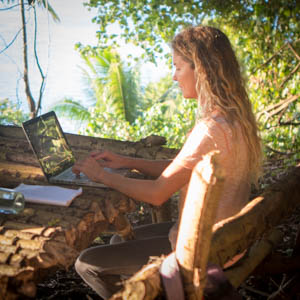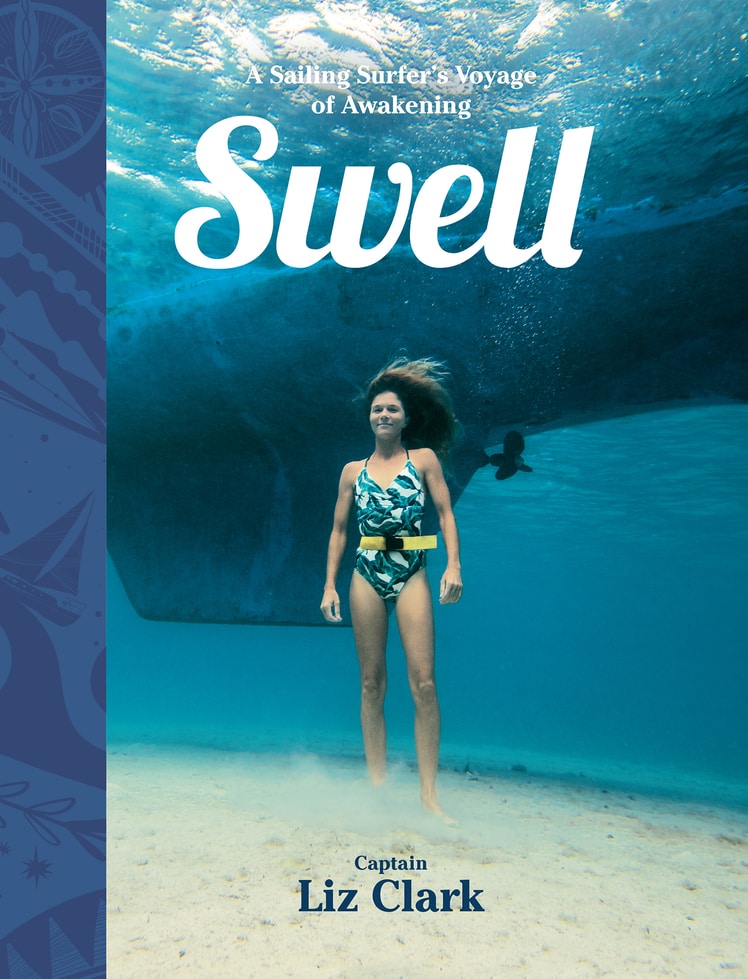Fenua Enata: Where’d everybody go?

The valley of Hikeu, topped by one of the island's legendary stone spires.
There is nothing like laying eyes on new land after a long, tough passage at sea. The remote, uninhabited bay was an ideal place to dry out, rest, and re-organize Swell. Over the week that followed, we set foot on solid land to stretch our legs and explore the jungle-covered valley. To our great delight, we found loads of wild food to be foraged! After a trip to the town on the southern point for drinking water, the locals assured us that we were welcome to eat anything growing the valley. Wild oranges, papayas, limes, pumpkin, fei bananas, grapefruit, guavas, and even taro and sweet potato roots! We sat in the shade and gorged ourselves on mangos until it hurt.

Papayas a plenty.
But apart from the edible bliss the valley offered, there was an unmistakable aura of mystery and tragedy in the air. Remnants of the ancient civilization that once blossomed there were all around us. The in-tact stone foundations of their homes–‘pae pae’ as they are called– nearly lined the river the entire length of the valley. The ancient Marquesans were skilled masons. They built these foundations for their homes and communal areas by artfully stacking (and often cutting) enormous stones into large flat areas on which they then built structures of coconut palm, bamboo, and other local woods. All those pae-paes, but yet wild goats and horses were the only other warm-blooded creatures to be found? Where’d everybody go?
Fenua Enata is the original name for the Marquesas Islands. It means ‘the land of people’, which suited the archipelago well before the catastrophe brought on by contact with European explorers in the 16th century. Fenua Enata supported an estimated 100,000 people on the six inhabited islands! In addition to the many native edibles already there, the Polynesians came with boars, sapling breadfruit trees, chickens, and surely some fruit varieties. Add the plentiful fish in the surrounding waters; no one went hungry.
In Herman Melville’s account of living among the locals in Fenua Enata in his book ‘Typee” in 1842, he describes a fully operational, well-structured society. He describes marvelous cooperative acts of building, tools crafted from stone and shells, and a clever way of storing breadfruit, their staple carbohydrate, so that it could be eaten throughout the off-season. And yes, cannibalism occurred–they believed that the power of a great warrior killed in battle could be passed on by ceremonially consuming a piece of his flesh. Only certain members of the tribe could participate in this ritual, it wasn’t just a random ‘all-you-can-eat’ human buffet like early explorers envisioned. And without pointing fingers, I can think of numerous barbaric acts that Europeans committed around the same time period!

A 'pae pae'–stone foundational structure of ancient Marquesan homes. Many locals' homes are still built upon them today.
Anyhow, because the islanders lacked natural immunity and experience treating the new diseases introduced by contact with European sailors, people died off in masses. The population was reduced to about 20,000 by the middle of the 19th century. Even after the French had taken claim to the islands by force, and despite the pleas from some of the French residing there in the years that followed, France refused medical aid. The population nearly died out entirely! At its lowest, the population of all six islands declined to just over 2,000 or in 1925…:(
Fortunately, the culture of Fenua Enata survived, but even today, the ‘Land of People’ is comparatively ‘people-less’, with the current population around 10,000 inhabitants. Not all the valleys are connected by roads. Horses, brought by the explorers, are still a highly used mode of transportation. But with modernity taking root, many people now choose to live in the more populated valleys–where there are schools for their children, stores, imported supplies, and more jobs available.
…Seated on my stone throne under the giant mango tree, I quietly paid respect to the ancient inhabitants of the valley, thanking them for planting the tree that bore the very piece of fruit in my hand…a legacy ongoing…
I cherished every moment in the valley where, for now, nature reigns…

Oops…so distracted by nature's beauty I stepped in the mud!




3 Comments
Steph Singer
March 9, 2012Liz, thank you for reminding all of us that nature is the most beautiful art form on earth. I thought of you this week not only when I saw The Lorax, but also when I read an article that culminated w/ the final thought, “The closer you get to nature, the closer you get to health” :) Can’t wait for more updates xo
Wayne
March 9, 2012Hi Lizzy and Raiarii,
I am amazed at the courage one must possess to make a passage like the two of you have just completed. WOW! Thanks for sharing.
I really enjoy your perspective on the places you visit.
Wayne
5 Of The Best: Thought-Provoking Excerpts from Patagonia’s The Cleanest Line | Outdoor Minded Mag
May 9, 2012[…] Photograph by Liz Clark […]